|
|
|
Published
on 4
Oct 2008
|
All rights reserved.
|
|
|
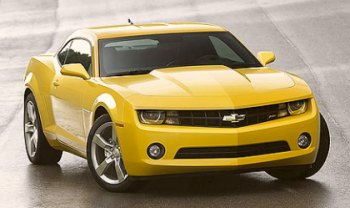
|
Chevy follows the footprints of
Mustang and Challenger to relaunch its pony car label...
|
Following
Ford Mustang and Dodge Challenger, Chevrolet Camaro is Detroit's third
act of pony cars revival. To American patriotic car lovers, Camaro is
hardly a stranger. General Motor's Chevrolet division created it in
1967 as a response to the huge sales success of Ford Mustang. Since
then it was continuously in production through 4 generations until
2002, when sales finally slided below break-even point. A few years
back, Detroit started reviving historic American icons to strike back
imports. History repeats itself. Ford was again the first to relaunch
pony cars with its new Mustang in late 2004. It was therefore rewarded
with good profit. Chrysler followed suit with Dodge Charger and more
recently Challenger. GM was late to the party again. It didn't show the
new Camaro to the public until the Detroit motor show in Jan 2006, and
that was concept car only. However, the reaction was so overwhelming
that it was soon greenlighted for production. The production car will
go on sale in March 2009.
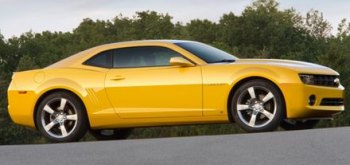
|
Reborn icons are often made retro for
the sake of retro. Not so the Chevy...
|
The
Chevy may be late to the market, but in return it is better developed
than its rivals. GM built it on the Zeta platform of Holden VE
Commodore thus it gets all the modern ingredients - strong chassis,
independent multi-link rear suspensions, all-wheel disc brakes,
variable ratio steering, multi-valve aluminum V6, 6-speed manual and
6-speed automatic gearbox... In the eyes of Bob Lutz, GM's product
boss, a retro design is not an excuse for outdated technologies and low
build quality. Under its iconic enclosure must be modern underpinnings.
I am totally agree with him.
Reborn icons are often made retro for the sake of retro, so they look
outdated and unpractical by modern standards. Camaro is much better in
this aspect. Although its 0.35-0.36 drag coefficient is far from
modern, its styling is by no means retro. While it shares some visual
features with the 1969 (1st generation) Camaro, it adapted those
features smartly into a modern proportion with long wheelbase, short
overhangs, strong shoulders, big wheelarches and nice detailing. This
is a wild and highly expressive design. Simultaneously, it provides the
form and functions of modern coupes. Its cabin is also much more
stylish and well built than those in Mustang and Challenger.
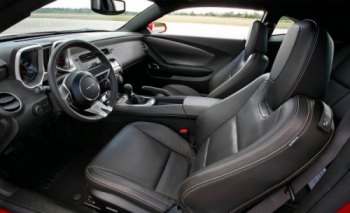
|
Limited visibility and tight rear room
aside, the interior is attractive...
|
Still,
you can criticize Camaro for its poor packaging efficiency. A 2+2 coupe
has no right to run a 2852mm wheelbase. Nor it should weigh in excess
of 1700 kilograms. Although it is smaller and lighter than Dodge
Challenger, it is considerably larger and heavier than Ford Mustang. It
was conceived at a time when economy was good and gas price was low. It
was derived from a robust platform developed by people from an equally
high-consuming country (Australia). In short, its fundamental had no
sense of fuel economy.
When oil price surged, GM responded by equipping the base Camaro with a
relatively efficient engine - Cadillac CTS' 3.6-liter DOHC VVT
direct-injection V6. This really caught me a surprise as I didn't
expect such a sophisticated engine for GM's pony car. It produces a
remarkable 304 horsepower in a willing manner. Redline is a very modern
7000 rpm. Of course, its bottom-end torque is no match with a big V8.
That's why the flagship Camaro SS will be powered a 422hp / 408 lb-ft
6.2-liter push-rod V8 from the latest Chevrolet Corvette. However,
expect the majority of sales will go to the V6, especially when it can
do 0-60 mph in a decent 6 seconds. We cannot rule out the possibility
for an even more frugal four-cylinder engine (e.g. Pontiac Solstice's
260hp 2.0 direct-injection turbo), but for sure it won't arrive in the
first model year.
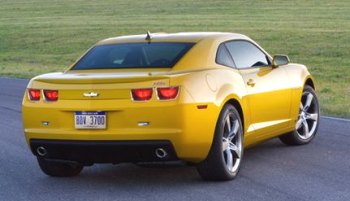 |
GM was late to the party again. Is it
too late to launch a new pony car ?
|
At
the
time of writing, the "99 percent completed" prototype has been driven
by many American magazines although it is still being subjected to fine
tuning. Testers were impressed by its rigid chassis, good damping and
agile handling. Its body control and bump absorption leaves Mustang
(with its live-axle rear suspension) for dead. It corners far more
stable and nimble than the cumbersome Challenger. It is easily the most
accomplished pony car to date. This is hardly a surprise to those
knowing Holden Commodore. The Camaro could only be better because of
its shorter wheelbase and stronger 2-door structure. Moreover, seeing
the recent Saturn Aura, Chevrolet Malibu and Cadillac CTS, I am
confident of GM's development commitment these days.
No matter from styling, mechanicals or early impression, Camaro is
likely to deserve greater success than Mustang and Challenger. However,
its rivals are not limited to those cars. Audi TT, Nissan 370Z, Hyundai
Genesis Coupe and Mazda RX-8 are also its competitors in the US market.
Under economic recession and high fuel price, will the pony car revival
be short-lived ? We shall see in a few years time.
|
Verdict:    |
Published
on 27
Jan 2011
|
All rights reserved.
|
|
Camaro ZL1
|
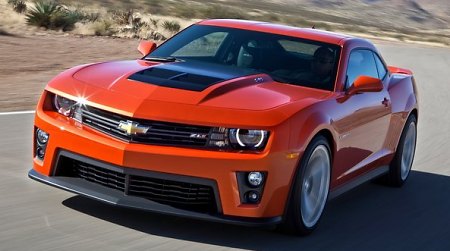
American pony cars used to
be known for a lot of bang for the buck. On the negative side, they
were just crap in all other aspects, such as handling, refinement,
build quality and attention to details. Some said you can't have the
best of both worlds. Recently, that conventional wisdom has been rolled
over by Ford Mustang Boss 302. This car is not only fast and affordable
but also handles and rides pretty well. More telling, it scores 4 stars
in our
rating, the first ever for an American pony car! It proves that only
the sky will be the limit to pony cars.
GM is not going to let Ford to rest on its laurel. Its new Chevy Camaro
ZL1 is meant to be the ultimate pony
car, or you may call the "Mustang-killer". Its performance attains a
level no pony cars have ever reached, thanks to an engine that is
not only larger than the Mustang's but also supercharged. Furthermore,
it
gets more sophisticated suspensions and electronic driving aids to
guarantee better handling and ride. At
US$56,000, it is the most expensive pony car you
can buy, but it still undercuts a properly equipped BMW M3 and Mercedes
C63 AMG Coupe by a good margin, let
alone those could match its 180 mph top speed and 4.0 seconds 0-60
mph acceleration.
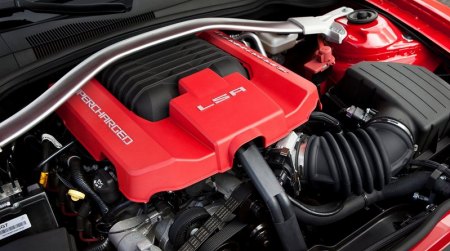
Externally, the ZL1 differs from lesser Camaros by a few details.
Its larger lower intake enhances cooling to the engine. Its aggressive
front splitter and skirts cut aerodynamic lift, as is the air
extractors opened on the bonnet. These aero tweaks contribute to 30kg
net downforce at 150 mph, compare with 90kg of lift on the regular
Camaro SS. However, the biggest visual change must be the huge power
bulge built on its bonnet. It is introduced to accommodate the Eaton
TVS supercharger and integral intercooler sitting atop the 6.2-liter
LSA small-block V8. This engine is basically the same as that serving
Cadillac CTS-V, just with different intake and exhaust tuning to
extract a little bit more punch. (Note: it is also a close relative to
the LS9 on Corvette ZR1, though that engine gets a higher volume
supercharger, higher compression and exotic lightweight parts like
titanium con-rods and valves) Meanwhile, a two-stage variable exhaust
is borrowed from the Corvette to enhance sound quality. With 580
horsepower and 556 pound-foot of torque, the ZL1 overshadows many
performance cars that cost 2 or 3 times the price, such as Nissan GT-R,
BMW M5 and Porsche 911 Turbo S.
Nevertheless, its Tremec TR6060 6-speed manual gearbox is not as
effective as modern twin-clutch gearboxes to transform the horsepower
into acceleration. Coupling to the fact that the ZL1 weighs as much as
1852 kg, even the best test conditions can hardly get 0-60 and 0-100
mph much below 4 and 9 seconds respectively. While it is unquestionably
the fastest 2+2 car for the price, it is probably not as fast as we
expected. 15 years ago, TVR
Cerbera 4.5 was already capable of such performance.
But one thing the Chevy does very well – and unexpectedly
well indeed – is real-world performance. It lapped Nurburgring in a
best time of 7 minutes and 41 seconds, faster than track-oriented
specials like Corvette Z06, Mercedes C63 AMG Black Coupe and BMW M3
GTS! The eye-popping lap time does not come by luck, of course. It is
down to many elements, such as the large Brembo brakes (370mm discs and
6-pot calipers up front; 365mm discs and 4-pot calipers at the rear),
gripper rubbers (285/35ZR20 and 305/35ZR20 Goodyear Eagle F1), a
limited slip differential, a 5-stage selectable traction and stability
control and the latest Gen 3 magnetorheological adaptive dampers which
react faster than the ones on CTS-V, Corvette ZR1 and Ferraris.
Finally, the chassis tuning is fine polished by countless of test laps
in Nurburgring, just like the best European and Japanese performance
machines. It is such attention to engineering that makes the ZL1 so
good to drive.
On race tracks, you will be amazed by its agility that belies its
weight. The handling attitude is much more neutral than the Camaro SS.
There is excellent front-end grip to resist understeer in corner entry.
Despite of the tremendous torque available for disposal, the power
delivery is linear so that you can feed the rear wheels precisely. Even
if you switch the traction control to the sportiest mode, the ZL1 won't
bite you. Its handling is surprisingly tamed for such a powerful,
rear-drive car. Power oversteer happens but it is progressive and
controllable. Compare with Boss 302, the most obvious advantage is
suspension – multi-link versus live-axle, magnetic adaptive damping
versus manually set damping. Its ride is very absorbent, keeping the
car planted to the road thus making the power more usable. As a result,
the ZL1 can corner at higher speed. In addition to strong braking and
grip, the brake cooling ducts, transmission and differential oil
coolers, the car is surprisingly effective for track days.
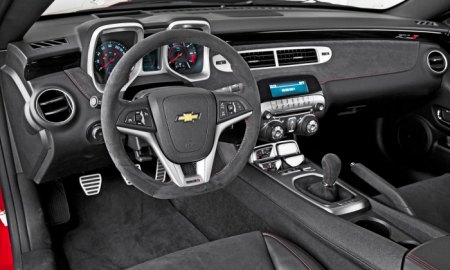
On the downside, the ZL1 is still troubled by the fundamental flaws
associated with all Camaros – a cheap interior (despite of Alcantara
trim), flat front seats, mediocre headroom and poor outward visibility.
The latter makes its 1918 mm width all the more difficult to contain on
narrower roads. Such a lack of attention to details still distinguishes
the super pony car from the best of the class. We won't trade an M3,
C63 AMG or GT-R with the ZL1, but if you cannot afford those better
polished cars, the ZL1 would be a great option. |
Verdict:     |
| Published
on 4
Apr
2014 |
All rights reserved.
|
|
Camaro Z/28
|
|
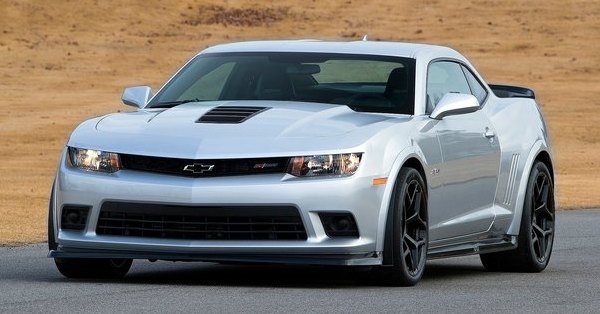
|
The Camaro Z/28 is a late
response to Ford Mustang Boss 302. 3 years ago, the Boss 302 surprised
us with its good performance and handling – it was probably the first
Mustang that cornered as well as it went straight. Its track-oriented
version, Laguna Seca, thrilled even more American motoring journalists.
If Ford can do, why not General Motors? Through the making of Cadillac
CTS-V, Corvette ZR1 and Camaro ZL1 in recent years, GM demonstrated it
has the competence to develop good performance cars. Building a
track-focused Camaro to beat Ford should not be a big
problem. The only problem is what nameplate to be adopted. Reviewing
the history of Camaro, a name was found to fit the purpose perfectly:
Z/28. Built between 1967 and 69, the original Z/28 was GM’s mass destruction
weapon in Trans Am racing series and was widely regarded as the best
Camaro of all. Now the new Z/28 is going to repeat history.
The Z/28 is not exactly the most powerful member of its family – that
is still the 6.2-liter supercharged ZL1. Undoubtedly, the latter is
faster in straight line, but Z/28 should be quicker overall because it
is lighter, balance better, grips harder and brakes stronger. Chevy
said initial testing found it is 3 seconds a lap quicker than the ZL1,
although it didn't say which racing circuit.
How is this possible? Let's look at the powertrain first. Its engine is
the same 7.0-liter LS7 V8 that used to serve C6 Z06, another race-bred
machine. It employs expensive titanium connecting rods and intake
valves to enable a 7000 rpm redline, remarkable for an old-school ohv
V8. The exhaust valves are filled with sodium to withstand high
temperature attained in racing conditions. The cylinder heads are CNC
machined to ensure high precision. Other goodies include 11.0:1
compression, high-lift camshaft, forged steel crankshaft and dry-sump
lubrication. It weighs almost 30 kg less than the ZL1 engine thus helps
balance. Maximum output is 505 horsepower and 481 lbft of torque,
released at 6100 rpm and 4800 rpm respectively.
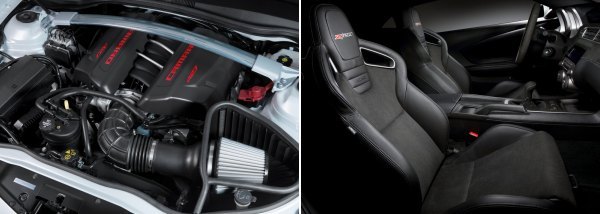
|
The Tremec 6-speed manual gearbox and Torsen limited slip
differential are carried over from the standard car but they get
dedicated oil coolers to withstand the stress of racing.
The suspensions remain passive, but they feature racing-style
spool-valve dampers, which can be finely tuned to deal with both
low-speed undulations and high-speed bumps. Springs have been stiffened
by 85 percent up front and 65 percent at the rear compared with Camaro
SS. Harder bushings and narrower anti-roll bars round up the suspension
mods.
The faster lap time is contributed mainly by 3 factors. Firstly, its
semi-racing Pirelli P-Zero Trofeo R tires, measuring a massive
305/30YR19 each corner (yes, including the front!), allow it to corner
at up to 1.05 g. Secondly, it employs Brembo carbon ceramic brakes as
standard, enabling a stopping power of 1.5 g. Thirdly, it underwent a
strict diet, cutting unnecessary fat like air-con, audio and sound
deadening.
A smaller battery and thinner rear glass are adopted. The 19-inch
forged alloy wheels and tires combine to save 19 kg over the original
20-inch items (while lowering center of gravity by 33 mm, by the way).
The CCM brakes save another 12.5 kg. Overall, the car is more than a
hundred kilograms lighter than ZL1.
In the aerodynamic side, the Z/28 adds an aggressive front air
splitter, side skirts and a big rear spoiler to generate positive down
force, even though 68 kg at 150 mph is not exactly remarkable.
On the Road
Unexpectedly, the driving experience is dominated by not the engine but
the chassis. Although the large V8 is strong and loud, its linear power
delivery
doesn’t feel as manic as a 991 Turbo on boost, and it doesn’t overwhelm
the grip and balance. The sensation of straight line speed is also
dampened by the weight – despite of the diet, the big Camaro still tips
the scale at 1.75 ton, something dictated by its old platform. This
mean it can go no quicker than 4 seconds in 0-60 and 9 seconds in 0-100
mph, which is fast but not outstanding. The gearshift is old-school
heavy and stiff. In contrast, the handling is superb. First to catch
your attention is the huge grip generated by those semi-slick tires. As
long as they have been warmed up and the road is dry, they offer
amazing cornering prowess. Moreover, with an oversized front tires, the
Z/28 refuses to understeer. It just nails on the desired path. The
chassis is well balanced, being very stable and predictable at the
limit. A well-tuned 5-mode traction control system keeps you out of
trouble should you apply more power than needed. When it comes to
deceleration, the ceramic brakes are epic. The Camaro Z/28 is not a
usual American muscle car. Its chassis is so good that it could take
more power!
The downside? Its stiff suspension offers little ride comfort. The
track tires do not cope well with wet surfaces and they are prone to
wear out quickly. The
abundance of noise and rattles in the cabin also means it is not a good
road car. Finally, the sticker price of US$75,000 is a lot more than
the now-defunct Boss 302 ($43K for the standard car or $50K for Laguna
Seca). Yes, it is also considerably more expensive than the ZL1 ($56K).
A Porsche 991 GT3 and Nissan GT-R are not too far beyond. Being more
track-focused than those rivals, the Chevy might put more smiles on the
faces of track-day enthusiasts, but its scope of talent is much
narrower. Still, the great effort is already worth praising.
|
Verdict:     |
|
|
|
|
|
|
|
|
|
|
Camaro 3.6 RS
|
2008
|
| Front-engined,
RWD |
| Steel monocoque |
| Mainly steel |
| 4836 / 1918 / 1377 mm |
| 2852 mm |
V6, 60-degree
|
| 3564 cc |
DOHC 24valves, DVVT
|
| - |
| DI |
304 hp / 6400 rpm
|
273 lbft / 5000 rpm
|
| 6-speed manual |
F: strut
R: multi-link
|
| - |
F: 245/55R18
R: 245/50R18
|
1707 kg
|
| 155 mph (limited) |
5.9* / 5.9**
|
14.8* / 14.9**
|
|
Camaro SS
|
2008
|
| Front-engined,
RWD |
| Steel monocoque |
| Mainly steel |
| 4836 / 1918 / 1377 mm |
| 2852 mm |
V8, 90-degree
|
| 6162 cc |
OHV 16 valves
|
| - |
| - |
426 hp / 5900 rpm
|
420 lbft / 4600 rpm
|
| 6-speed manual |
F: strut
R: multi-link
|
| - |
F: 245/45ZR20
R: 275/40ZR20
|
1750 kg
|
| 155 mph (limited) |
4.6* / 4.7** / 4.6***
|
10.5* / 10.5** / 10.5***
|
|
Camaro ZL1
|
2012
|
| Front-engined,
RWD |
| Steel monocoque |
| Mainly steel |
| 4836 / 1918 / 1377 mm |
| 2852 mm |
V8, 90-degree
|
| 6162 cc |
OHV 16 valves
|
| Supercharger |
| - |
580 hp / 6100 rpm
|
556 lbft / 3800 rpm
|
| 6-speed manual |
F: strut
R: multi-link
|
Adaptive damping
|
F: 285/35ZR20
R: 305/35ZR20
|
1852 kg
|
| 180 mph (c) |
4.0 (c) / 4.1* / 3.8** / 4.3****
|
8.9* / 8.7** / 9.5****
|
|
|
|
|
|
Performance
tested by: *C&D, **MT, ***R&T, ****Automobile
|
|
|
|
|
|
|
Camaro Z/28
|
2014
|
| Front-engined,
RWD |
| Steel monocoque |
| Mainly steel |
| 4885 / 1953 / 1330 mm |
| 2852 mm |
V8, 90-degree
|
| 7008 cc |
OHV 16 valves
|
| - |
| - |
505 hp / 6100 rpm
|
481 lbft / 4800 rpm
|
| 6-speed manual |
F: strut
R: multi-link
|
-
|
All: 305/30YR19
|
1746 kg
|
| 172 mph (c) |
4.4* / 4.0** / 4.1***
|
9.5* / 9.0** / 9.2***
|
|
|
|
|
|
|
|
Performance
tested by: *C&D, **MT, ***R&T
|
|
|
|
|
|
|
|
|
Copyright©
1997-2014
by Mark Wan @ AutoZine
|
|